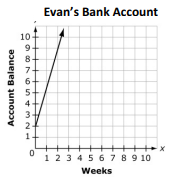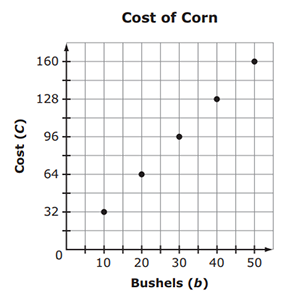Clusters should not be sorted from Major to Supporting and then taught in that order. To do so would strip the coherence of the mathematical ideas and miss the opportunity to enhance the major work of the grade with the supporting clusters.
- Assessment Limits :
Items must involve relationships and/or equations of the form ???? = ???????? or ???? = ???? + ????. Numbers in items should not require students to perform operations with negative rational numbers or result in answers with negative rational numbers. Variables need to be defined. - Calculator :
No
- Context :
Required
- Test Item #: Sample Item 1
- Question: A graph of Evan’s bank account is shown. What are the dependent and independent
variables?

- Difficulty: N/A
- Type: MI: Matching Item
- Test Item #: Sample Item 2
- Question: The cost per bushel of corn at Farm A is constant. The graph shows the
total cost, C, in dollars, of purchasing different numbers of bushels of
corn, b, at a farm.

In the table below, select the phrase that represents the independent variable, the phrase that represents the dependent variable, and the equation that represents the graph.
- Difficulty: N/A
- Type: SHT: Selectable Hot Text
Related Courses
Related Access Points
Related Resources
Formative Assessments
Lesson Plans
Original Student Tutorial
Problem-Solving Task
Student Center Activity
Teaching Idea
Tutorials
Unit/Lesson Sequence
STEM Lessons - Model Eliciting Activity
Students are asked to evaluate and test several rocket fin designs to determine the most effective design. After launch, the students are asked to test an additional design and also design their own rocket fin. Additionally, students will record and graph their results.
Model Eliciting Activities, MEAs, are open-ended, interdisciplinary problem-solving activities that are meant to reveal students’ thinking about the concepts embedded in realistic situations. Click here to learn more about MEAs and how they can transform your classroom.
This activity engages the students into time scheduling, budgeting, and decision making to maximize time efficiency.
Model Eliciting Activities, MEAs, are open-ended, interdisciplinary problem-solving activities that are meant to reveal students’ thinking about the concepts embedded in realistic situations. MEAs resemble engineering problems and encourage students to create solutions in the form of mathematical and scientific models. Students work in teams to apply their knowledge of science and mathematics to solve an open-ended problem while considering constraints and tradeoffs. Students integrate their ELA skills into MEAs as they are asked to clearly document their thought processes. MEAs follow a problem-based, student-centered approach to learning, where students are encouraged to grapple with the problem while the teacher acts as a facilitator. To learn more about MEAs visit: https://www.cpalms.org/cpalms/mea.aspx.
MFAS Formative Assessments
Students are given an equation in context and are asked to use the equation to make a table of values and a graph. Students are also asked to explain how the equation shows the relationship between the independent and dependent variables.
Students are asked to write an equation from a real-world context and identify and describe the independent and dependent variables.
Students are asked to write equations from real-world contexts and identify the independent and dependent variables.
Students are asked to write an equation that represents the relationship between two variables and to explain how the equation reflects the relationship.
Computer Science Original Student Tutorials
Explore computer coding on the farm by using relational operators and IF statements to evaluate expressions. In this interactive tutorial, you'll also solve problems involving inequalities.
Click below to check out the other tutorials in the series.
Student Resources
Original Student Tutorial
Explore computer coding on the farm by using relational operators and IF statements to evaluate expressions. In this interactive tutorial, you'll also solve problems involving inequalities.
Click below to check out the other tutorials in the series.
- MacCoder’s Farm Part 1: Declare Variables
- MacCoder's Farm Part 2: Condition Statements
- MacCoder's Farm Part 4: Repeat Loops
Type: Original Student Tutorial
Problem-Solving Task
In this task students use different representations to analyze the relationship between two quantities and to solve a real world problem. The situation presented provides a good opportunity to make connections between the information provided by tables, graphs and equations. In the later part of the problem, the numbers are big enough so that using the formula is the most efficient way to solve the problem; however, creative use of the table or graph will also work.
Type: Problem-Solving Task
Student Center Activity
Students can practice answering mathematics questions on a variety of topics. With an account, students can save their work and send it to their teacher when complete.
Type: Student Center Activity
Tutorials
In an equation with 2 variables, we will be able to determine which is the dependent variable, and which is the independent variable.
Type: Tutorial
Given a graph, we will be able to find the equation it represents.
Type: Tutorial
Parent Resources
Problem-Solving Task
In this task students use different representations to analyze the relationship between two quantities and to solve a real world problem. The situation presented provides a good opportunity to make connections between the information provided by tables, graphs and equations. In the later part of the problem, the numbers are big enough so that using the formula is the most efficient way to solve the problem; however, creative use of the table or graph will also work.
Type: Problem-Solving Task








